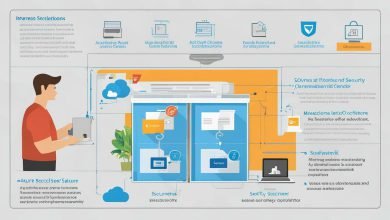
Software development is an evolving landscape, and complex business tasks require strategic design approaches that optimize efficiency, performance, and maintainability. Domain-Driven Design (DDD) is one such approach that has gained significant traction in recent years. Adopting DDD can help businesses unlock their potential by streamlining software development for complex tasks.
DDD is a software development approach that focuses on identifying and defining the core domain of a business problem. It promotes collaboration between business stakeholders and developers to establish a ubiquitous language and domain model. By adopting DDD as a strategic design approach, software engineers can create more efficient, maintainable, and scalable systems.
Key Takeaways
- Domain-Driven Design is a strategic design approach in software engineering.
- DDD focuses on identifying and defining the core domain of a business problem.
- DDD promotes collaboration between business stakeholders and developers to establish a ubiquitous language and domain model.
- By adopting DDD, software engineers can create more efficient, maintainable, and scalable systems.
Understanding Domain-Driven Design
Domain-Driven Design (DDD) is a software development approach that emphasizes a strategic design based on a deep understanding of the business domain. DDD is gaining popularity among software engineers as a way of tackling complex business tasks and optimizing development processes.
DDD is a software engineering approach that emphasizes the importance of designing software systems based on the business domain. The goal is to create software systems that closely match the needs and requirements of the business, rather than forcing the business to adapt to the limitations of the software.
DDD focuses on the business domain by introducing the concept of bounded contexts, which define specific areas or sub-domains within the business. Each bounded context has its own domain model, which is a conceptual model of the business domain that describes the entities, relationships, and behavior within that context. DDD also introduces the concept of ubiquitous language, which is a common language used by both the business stakeholders and the development team to describe the domain and the software system.
Benefits of Domain-Driven Design
Domain-Driven Design (DDD) has several benefits that make it a popular software development approach. By adopting DDD as a strategic design approach in software engineering, developers can optimize software development for complex business tasks. Here are some of the major benefits of implementing Domain-Driven Design:
Improved Collaboration and Communication
One of the most significant benefits of DDD’s approach is to help establish a common language between developers and business stakeholders. Since DDD emphasizes the use of a ubiquitous language, it promotes better collaboration and communication between business stakeholders and developers. By aligning the domain model with the business goals and processes, it helps ensure that developers understand the business context and requirements of the software.
Better Code Quality and Maintainability
By using DDD, developers can achieve better code quality and maintainability. The use of bounded contexts helps to break down complex domains into smaller, more manageable parts, making it easier to maintain code over time. DDD also promotes the use of object-oriented programming (OOP) principles, which can produce cleaner and more organized code.
Enhanced System Performance
DDD has been shown to enhance overall system performance by minimizing unnecessary complexity and reducing technical debt. By isolating the different domains through bounded contexts and domain models, developers can focus on optimizing each domain separately, leading to a more efficient system overall.
Implementing Domain-Driven Design in Practice
Implementing Domain-Driven Design requires careful planning and execution. Here are the key steps to follow:
- Identify and define bounded contexts: Bounded contexts are the fundamental units of DDD. They represent a specific area of the business domain that is isolated from other contexts. Identifying bounded contexts requires collaboration between domain experts and developers to ensure a shared understanding of the business domain. Once identified, contexts must be defined in terms of their boundaries, responsibilities, and relationships to other contexts.
- Create a domain model: A domain model is a representation of the business domain in code. It consists of entities, value objects, and aggregates that map to the concepts and relationships of the business domain. Creating a domain model requires an object-oriented mindset and a deep understanding of the business domain. The domain model should reflect the ubiquitous language used by domain experts.
- Establish a ubiquitous language: A ubiquitous language is a common language used by domain experts and developers to talk about the business domain. It ensures that everyone involved in the project has a shared understanding of the domain concepts and their meaning. Establishing a ubiquitous language requires active collaboration and continuous refinement throughout the project.
It is important to note that implementing Domain-Driven Design is an iterative process. The key is to continuously refine and adapt the design based on feedback from domain experts and users. This requires a flexible and collaborative development process.
Case Studies: Real-world Applications of Domain-Driven Design
Domain-Driven Design has been successfully applied in a variety of industries, demonstrating its potential impact in improving software development for complex business tasks. Here are some real-world case studies:
Financial Services
A large financial institution adopted Domain-Driven Design to improve their loan processing system. By utilizing bounded contexts and a domain model, they were able to streamline their loan origination process, reduce errors, and decrease processing time by 30%. This resulted in higher customer satisfaction and increased revenue.
Healthcare
A healthcare provider leveraged Domain-Driven Design to develop a patient-centric electronic medical records system. By utilizing a ubiquitous language and domain model, they were able to improve data accuracy, enhance communication between healthcare providers, and increase patient satisfaction. This resulted in better health outcomes and reduced costs.
These case studies demonstrate the transformative power of Domain-Driven Design in optimizing software development for complex business tasks. By adopting DDD as a strategic design approach, organizations can improve collaboration, code quality, and system performance, while achieving their business goals.
Challenges and Pitfalls of Domain-Driven Design
While Domain-Driven Design offers many benefits for software development, organizations may encounter challenges when adopting this approach. It’s important to address these challenges proactively to ensure a smooth transition to DDD.
Common Misconceptions
One of the most common misconceptions about DDD is that it’s too complex and time-consuming to implement. While DDD does require a strategic design approach, it can be adapted to fit the needs of any organization. Additionally, some developers may struggle with the shift to an object-oriented design approach if they are used to more traditional methods.
Potential Risks
Another challenge of DDD implementation is the potential risk of over-engineering. If not properly managed, DDD can lead to an overly complex system and slow down the development process. Additionally, it can be difficult to maintain consistency in the ubiquitous language across all teams involved in the project.
Strategies to Mitigate Challenges
To mitigate these challenges, organizations can take several steps. First, it’s important to provide proper training and support to help developers adjust to the new design approach. Additionally, teams should work closely with business stakeholders to ensure that the domain model accurately reflects the needs of the business.
Regular and continuous refinement is also key to avoiding over-engineering and maintaining consistency across teams. Finally, it’s important to regularly assess the effectiveness of the DDD implementation and make adjustments as necessary.
Domain-Driven Design vs. Other Software Development Approaches
While there are numerous software development approaches available today, Domain-Driven Design stands out in its unique approach to handling complexity. Unlike the traditional Waterfall methodology, which follows a linear and sequential process from start to finish, DDD takes a more iterative and collaborative approach to software engineering.
Similarly, Agile and DevOps methodologies focus on delivering software in small increments and continuous testing and deployment, respectively. While these approaches can be effective for smaller projects, they may not be suitable for larger, more complex applications where DDD shines.
The key differentiator of DDD is its emphasis on strategic design. It puts the business domain at the forefront of software development, allowing developers to better understand and model complex business processes. By dividing the system into smaller, bounded contexts, developers can focus on specific business requirements while maintaining consistency across the entire system.
Furthermore, DDD’s use of ubiquitous language creates a shared understanding between business stakeholders and developers. This helps minimize misunderstandings and improve collaboration, leading to better software outcomes.
Future Trends and Innovations in Domain-Driven Design
As software development continues to evolve, Domain-Driven Design (DDD) is also experiencing new trends and innovations. One significant trend is the increasing use of machine learning and artificial intelligence in DDD. This can enhance the accuracy and effectiveness of domain modeling, making it easier to identify and define bounded contexts.
Another emerging trend is the integration of DDD with microservices architecture. This allows for more modular and scalable software development, enabling teams to break down complex business tasks into smaller, more manageable units. Additionally, DDD can help ensure that each microservice has a well-defined purpose and a clear understanding of the domain it operates in.
One innovation in DDD is the use of event storming, a collaborative workshop technique that helps teams understand complex business domains and identify potential domain events. This approach can lead to the creation of more accurate and effective domain models, as it encourages active participation and cross-functional knowledge sharing.
Other innovations in DDD include the use of data-driven domain models, which leverage big data analytics and machine learning to improve the accuracy and effectiveness of domain modeling. Additionally, some organizations are exploring the use of domain-specific languages, which allow developers to define domain concepts and entities in a more natural and concise way.
As these trends and innovations continue to shape the evolution of DDD, it’s essential for developers to stay up-to-date and explore new approaches to optimize software development for complex business tasks.
Best Practices for Domain-Driven Design Adoption
Adopting Domain-Driven Design (DDD) can be a daunting task. It requires a significant shift in mindset and culture. However, with the right approach, DDD can deliver tremendous benefits.
Here are some best practices for successful adoption of DDD:
- Collaboration: One of the key principles of DDD is collaboration between business stakeholders and developers. It’s essential to establish a shared understanding of the problem domain and agree on a common language. Foster an environment of open communication and regular feedback loops to ensure success.
- Continuous learning: DDD is a continuous process of refinement and adaptation. It’s crucial to invest in ongoing education and training to stay up-to-date with the latest trends and best practices. Encourage team members to share their knowledge and experiences to promote a culture of continuous learning.
- Business goals alignment: DDD is a strategic approach to software design, aimed at solving complex business problems. It’s critical to align DDD implementation with business goals and priorities. Identify the core business capabilities and design the system around them.
By following these best practices, organizations can maximize the benefits of DDD implementation and achieve success in software development.
Conclusion
Domain-Driven Design (DDD) is a powerful software development approach that enables organizations to optimize their systems for complex business tasks. By adopting DDD as a strategic design approach in software engineering, organizations can improve collaboration between business stakeholders and developers, enhance code quality and maintainability, and enhance overall system performance.
In conclusion, DDD offers significant benefits for software development projects in various industries. By following best practices for successful DDD adoption, such as team collaboration, continuous learning, and alignment with business goals, organizations can maximize the benefits of DDD implementation.
The Future of DDD
As emerging technologies and methodologies continue to shape the evolution of DDD, developers must stay up-to-date to leverage the power of DDD. Future trends and innovations will likely focus on enhancing scalability, improving testability, and incorporating machine learning and AI.
In summary, DDD is a software development approach that offers a strategic and effective way of building complex business systems. By leveraging DDD, organizations can unlock their potential and achieve their business goals more efficiently and effectively.
FAQ
Q: What is Domain-Driven Design (DDD)?
A: Domain-Driven Design (DDD) is a software development approach that focuses on building software systems that align closely with complex business domains. It emphasizes the use of strategic design and a collaborative approach between business stakeholders and developers.
Q: What are the fundamental principles of Domain-Driven Design?
A: Some fundamental principles of Domain-Driven Design include bounded contexts, which define the scope and boundaries of different parts of a system, domain models, which represent the key concepts and relationships within a domain, and ubiquitous language, which establishes a common language for communication between stakeholders and developers.
Q: What are the benefits of implementing Domain-Driven Design?
A: Implementing Domain-Driven Design can lead to better collaboration between business stakeholders and developers, improved code quality and maintainability, enhanced system performance, and a more efficient and effective software development process.
Q: How do you implement Domain-Driven Design in practice?
A: Implementing Domain-Driven Design involves identifying and defining bounded contexts, creating a domain model, establishing a ubiquitous language, and continuously refining and adapting the design based on feedback and evolving business requirements.
Q: Can you provide examples of real-world applications of Domain-Driven Design?
A: Yes, Domain-Driven Design has been successfully applied in various industries, such as finance, e-commerce, and healthcare. Real-world case studies have shown how DDD can improve the efficiency and effectiveness of software development projects.
Q: What are some challenges and pitfalls of adopting Domain-Driven Design?
A: Common challenges and pitfalls of adopting Domain-Driven Design include misconceptions about the approach, potential risks related to complex business domains, and difficulties in aligning the design with evolving business requirements. However, these challenges can be mitigated through proactive strategies and continuous learning.
Q: How does Domain-Driven Design compare to other software development approaches?
A: Domain-Driven Design offers unique advantages compared to other approaches such as Waterfall, Agile, and DevOps. It promotes a more strategic and collaborative approach, emphasizes domain expertise, and enables better alignment with complex business requirements.
Q: What are the future trends and innovations in Domain-Driven Design?
A: The future of Domain-Driven Design is shaped by emerging technologies and methodologies. Innovations such as event-driven architectures, microservices, and machine learning are influencing the evolution of DDD and opening up new possibilities for software development.
Q: What are the best practices for successful Domain-Driven Design adoption?
A: Some best practices for successful Domain-Driven Design adoption include fostering team collaboration, continuous learning and improvement, aligning the design with business goals, and staying updated with the latest trends and practices in DDD.








